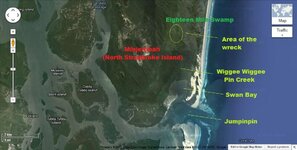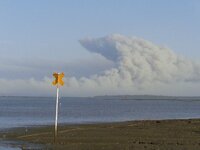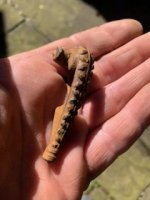OzSwampfrog
Greenie
- Oct 9, 2013
- 15
- 3
- Primary Interest:
- All Treasure Hunting
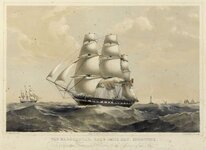
This ship has fascinated treasure hunters for 160 years, because her wreck has supposedly never been found. What makes her interesting to most people is her cargo, 60,542 ounces of gold dust, more than two tons, packed into 86 boxes, and nine crates of gold sovereigns, containing many thousands of these valuable coins. At today's prices, that gold would be worth over US $100,000,000.
The frigate-built Blackwall Liner was last seen sailing out of Hobson's Bay, at that time the name of the port of Melbourne, Australia, in August, 1853. She was bound for London and her normal route would have taken her there via Cape Horn, but did she really sail in that direction?
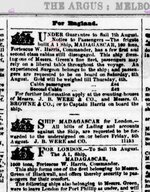
Among the passengers was a certain Mr Francis, the brother of a man arrested on board the ship weeks before she sailed for taking part in the robbery of another gold transport, under escort from the McIvor goldfields to Melbourne. The brother and two others who had planned to sail to London on board the Madagascar were later convicted for their part in that robbery and hanged. Francis was allowed to depart because turned "Queens Evidence" which led to his brother committing suicide in prison and the conviction of the others. It was stated that he had been allowed to sail because of a lack of evidence in a very unusual newspaper advertisement the following year and that there was "one person only that had left in her, to whom any suspicion attached as being connected with the escort robbery". There may however have been more.
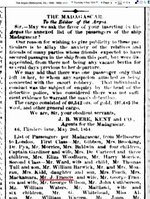
We know the details of the arrests on the Madagascar through Victorian detective, Mr J Tuckwell, who had also been concerned at the sight he had seen from the poop deck of the ship while he was there arresting the robbery suspects. There were "drunken men and women, swearing and fighting" and "howling like wild beasts". He stated that the crew was the "most villainous motley lot that had ever signed articles on a capstan's head" and added that "among the passengers were escaped convicts of the worst class"1. He was deeply concerned for the safety of the other passengers. At that time, the most hardened convicts had been sent to the toughest penal colonies in Australia, Port Arthur in Tasmania, Norfolk Island and the Moreton Bay Settlement from 1824. The captain would however have signed even doubtful looking ex-convicts as crew, because he needed 60 men to sail the ship. A dozen had already deserted to try their luck in the goldfields when the Madagascar had arrived at Melbourne and her departure had been delayed because the captain had some difficulty finding enough crew.
Francis and the other 103 passengers disappeared, as did Captain Fortescue Harrris and some of the crew of around 60, although other members of the crew had allegedly been seen again in the goldfields of Victoria the following year. This would contradict the ship having been set on fire off the coast of South America. On board was also allegedly a Mr Robson, who, it was claimed in a newspaper article in 1875, had also been part of the gang that robbed the McIvor gold transport2.
There were stories years later from a "deathbed confession" of a lady who had survived the mutiny of the crew and burning of the ship with the passengers locked inside somewhere "off the coast of South America", but these can not be verified. According to versions of this story, the mutineers had tried to load some of the gold onto the ship's longboat, capsizing it in the process. Supposedly, only a few survived and landed somewhere on the South American continent. An other story involving yet another "deathbed confession" involves former English servant Robson, who supposedly murdered the captain.
Would part of a crew and even a passenger, having planned such a heist, have been so stupid as to try and offload part of the two ton haul of gold onto the ship's longboat while at sea? To do what? Land and drag it across South America and sell it somewhere? There have always been very stupid criminals, but the planning displayed at the McIvor robbery indicates that this gang would most likely have made far better plans.
But where could such a mutinous crew have tried to take the gold to sell it? The ship would have been recognized in any port. Sailing it to England would have been suicide because the ship would have been reported. New Zealand had barely been colonized and anyone turning up with a large amount of gold to sell there would again have attracted too much attention.
A group of investors had even financed a search of the entire coast of New Zealand some years after the ship's disappearance, but the search found nothing, so New Zealand should be ruled out as her destination. South America would have proven difficult as a continent on which to land and sell so much gold due to language. But where were the boundaries of Australian colonization at the time? The attached map shows areas settled by the 1850s.
If only part of the crew had mutinied, it's doubtful any of them would have known how to navigate at sea. They would have hugged the coast. With the prevailing winds to the south of Australia blowing west to east, would they have attempted to sail north along the east coast?
The furthermost outpost of European civilization along the east coast of Australia in 1853 was Moreton Bay, which would have been known to an escaped convict who had been sent to the particularly tough penal colony, where repeat offenders had been sent, which had been established there in 1824. North of this frontier, there were no European settlements on the coast of what is now Queensland. Just the place not to be discovered. There were only about two thousand free settlers and convicts around Moreton Bay by the early 1850s. We know that several "escaped convicts" of the "worst kind" had been among the crew of the Madagascar through Detective Tuckwell's report. Some of them may have, through earlier incarceration at the penal colony there, have had knowledge of the area's remote hiding possibilities, because convict labor gangs were often sent to cut wood on the island. Remote, yet still close enough to the new town of Brisbane, with the first bank just established in 1850 to offer a possible place to sell gold? At least, was this the the intention of the mutineers?
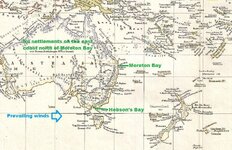
If the cargo of the Madagascar had been found, even only part of it, and not officially reported for obvious reasons, it stands to reason that there would at least be stories of gold sovereigns or of the gold dust in those 86 boxes. Are there any such stories from the Moreton Bay area? Surprisingly, there are. They are not well publicized, but they belong to the history of Stradbroke island. They include the only stories of someone having found a chest or crate of gold sovereigns anywhere along the Australian coast. They also mention a place where the wreck of a ship has been able to remain hidden until now.
Fraser Brown was an Aboriginal stockman, or "cowboy", to use the American term. He rode all over Stradbroke Island on his horse, rounding up stray cattle for a living. Because of this, he had access to areas of the island few people ever saw. His people tell of him finding an old ship's bell and a crate or chest of gold sovereigns on an old wreck in the Eighteen Mile Swamp. The story goes that he and a friend tried to carry them back to his home outside Dunwich, on the north west side of the almost 40km long island, but that they had become too heavy and that they had buried them in the bush, hoping to retrieve them later. Later however, he couldn't find them again...
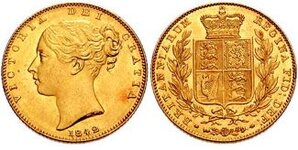
A tall story? Possibly. That's what most people on the island believe today, even some of the Aboriginal people of the island with their strong oral histories. But there was also a gold coin which Fraser is reputed to have found. A gold sovereign. There is also a lot of false information about other coins supposedly found on the island. They range from a complete fabrication about a "Spanish" coin being found and another in 2007 which was an Elizabethan sixpence, minted in 1593. A historian from the Queensland Museum stated about the latter that "just because a coin is 500 years old doesn't mean it wasn't dropped there yesterday". A polite way of saying that it could have been planted? I can't state the source because of confidentiality, but I have verified via a witness who would know the truth that this is indeed likely to be the case, a matter of getting free publicity for a book. There was however a coin that really was found on the island.
According to the President of the Island's Historical Society, that coin was in fact a gold sovereign, and it had been found by none other than Fraser Brown. Nobody knows where he found it for sure, but too many people have seen the coin for it to be dismissed as mere "island lore". At least this part of his story must therefore be true.
A gold coin, a sovereign, owned by the man who supposedly had found a chest or crate full of these on a wreck, along with a bell. But what about the bell? It was found around thirty years ago and is now in private ownership on the island. The owner kindly allowed me to see it recently and I photographed it both inside and out. The owner had told me that there was no writing on it. Fraser's people believe it was the bell he had buried, because it was found by a bulldozer driver (the deceased husband of the lady who now owns it) in the same area where Fraser had said he had buried it.
The bulldozer driver, who had worked for a sand mining company, had, according to the supervisor of the group, with whom I recently verified the story, "been on a smoko (break) and gone into the bush for a ****". He came back carrying the bell. So the missing piece had not been "sheared off by a bulldozer" as some sources claim. Some also say this is not a ship's bell and there's a complicated story of Fraser Brown allegedly having "stolen" the bell of the island's Benevolent Asylum when it closed on 1946. The Aboriginal people of the island don't believe this story, it's mainly told by non-aboriginal people. Yes, there was an Asylum bell, yes, it was a large bell and it went missing in 1946, but it had been mounted outside the Mess Hall of the Asylum for many years. Nobody knows who took it and what happened to it, but when Frazer found a large bell years later, non-Aboriginal people simply jumped to the conclusion that it had to be the same bell. The bell found 30 years ago that appears to be the one Fraser buried shows signs of fire damage. There was however never a fire at the Asylum's Mess Hall and the timbers of that building were taken down in 1946 and re-erected a short distance away, as the island's Community Hall, which still stands today.
The bell found 30 years ago was too far from where the Asylum had been for Fraser to have "just gone into the bush to hide it", because the area where it was found is at least a three hour hike away. Carrying a heavy bronze bell? It would have been easier to have secretly buried it much closer to the Asylum. That bell also has a large piece missing, damage that was most likely caused by the intense heat of a prolonged fire. It also shows other signs of exposure to fire. A fire that never had occurred at the Asylum's Mess Hall. A fire that could however have occurred on a ship or even at the wreck site, when exposed timbers were periodically burned by fires raging through the swamp after dry periods. A fire just like the one after which Fraser Brown had found the bell on the wreck deep inside the swamp. The place where it was found is very roughly a third of the way between Dunwich and the wreck site, close to a track which Fraser is likely to have taken on the way home from the swamp. The evidence appears to fit Fraser's story, and not the notion that it was the Asylum bell.
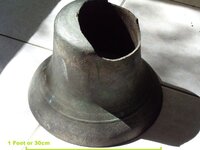
Examining the photos I had taken of the bell when I arrived home, I noticed some very faint writing inside it. Attached is a photo. You can make out the letters "A 1" (it's not "A L" because what at first appears to be the bottom stroke of the "L" has a different color and is not as thick as the rest of the letter) and above that two numbers of what might have once been four, "5 3". The bell is, according to English bell experts, 19th century and is cast in high quality bronze.
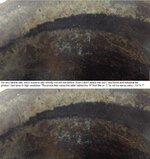
The Madagascar had been restored in England before sailing to Australia in 1853. After this restoration work, to gain the for insurance purposes at that time all important A 1 classification from Lloyd's of London, the entire ship had to be re-assessed. She indeed passed as A1 again, as Lloyd's Shipping Register for 1853 and newspaper ads from 1853 advertising passage to England from Melbourne tell us. Had the person conducting the assessment pedantically marked that the ship's foremast bell, a vital part of safety equipment at the time, after finding it to be in good working order with a ringer that worked, had passed inspection in 1853? He would have had to have turned up the bell and looked inside to check. The marks are inside the bell, where they weren't noticed by anyone until now.
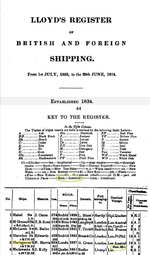
A few years ago, a scan of the southern area of the Eighteen Mile Swamp was commissioned. It resulted in two areas of wreckage being found, one containing a large amount of metal.
The first maps of the area, from 1842 or later, which would have been available in 1853, show a "boat passage" to the south of the area in the swamp where the wreck now lies, a few miles up Wigee Wigee Pin Creek. Could a 1000 ton ship have entered the boat passage and sailed so far up the creek? No, because the boat passage is very tricky and only for smaller vessels and then, as today, fallen trees and areas of thick vegetation block the creek totally only a short distance up from Swan Bay. In 1877 however a roughly one meter high tsunami wave was recorded, rushing north along the Eastern Australian Coast at a velocity of a few hundred km per hour. It struck an area just south of Swan Bay called Jumpinpin, where two independent witness reports had placed a large, already heavily charred wreck on the ocean beach. The tsunami struck the beach at Jumpinpin almost exactly at high tide. The dunes at this point (the sand spit washed away in the 1890s to form what is now the "Jumpinpin Channel") were only a few feet high, so only a thin, low stretch of sand, a hundred feet or so wide, separated the ocean beach from Swan Bay and the swamp beyond. The direction of that tsunami wave and the area where the wreck on the beach was seen match a line connecting the area of the swamp where the wreck has been located.
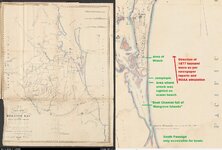
One recollection of this tsunami is by a Mr. Willes, the first European settler on Russell Island. In his papers he recalls a giant wave which deposited so much silt in southern Moreton Bay that it wiped out the entire oyster industry. It was Mr Willes who had also seen the wreck on the beach at Jumpinpin. A giant wave at Jumpinpin is also implied in the Collected Works of local historian Thomas Welsby. Welby had endeavoured to record the meaning of Aboriginal place names and some of the words of their languages. An Elder had told him that the name "Jumpinpin" meant "Big Fellow Wave" in the Pidgin English spoken by Aboriginal people in the mid to late 1800s. One particular giant wave?
The Madagascar had been frigate built, meaning also she had a poop deck and a forecastle. Evidence of a "high" poop deck and forecastle had been reported by one of the first people reported to have seen the wreck in the 1890s, Matthew Heeb, according to historian Isobel Hannah. This was what gave rise to the legend of the "Stradbroke Island Galleon". Heeb also salvaged around 60kg of fine copper bolts from the wreck. Former shipwright Heeb also claimed that the ship had been built of "English oak". The early Blackwall Liners like the Madagascar had been built of oak and were also copper bolt fastened. Their stern and bow sections were higher, compared to other ships at that time, becausee of the frigate design. The witness who saw the charred wreck on the ocean beach at Jumpinpin, as recorded by marine Archaeologist AJ Pixley, also noted a high poop deck. The higher stern and forecastle, the high quality copper bolts, English oak beams, tales of a crate or chest of gold sovereigns, the large and heavy bronze bell from a substantial ship, bearing writing inside that appears to be from the Lloyd's A1 survey in 1853... Can this all be mere coincidence?
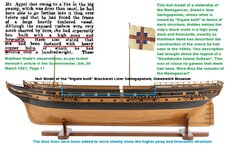
Had a plan by the mutineers to land the ship near the "last outpost of European civilization" at the time, Moreton Bay, gone terribly wrong? Had the ship caught fire or been deliberately set alight off the beach to destroy the evidence? Could the remains of the ship have been washed onto the beach by a storm years later and washed inland by the tsunami in May 1877? Nobody knows. There was another tsunami wave in 1868, but it struck the area on an outgoing tide. We don't have records of any tsunami events on the Eastern Australian Coast before the 1860s, when the first automatic tidal recording device was installed at Fort Denison in Sydney. Was there an earlier tsunami in the 1850s?
Word of such a wreck and the cargo must however surely have leaked out at some time. It may have, and not just the stories of the crate of gold coins and the gold sovereign. In 1915, four men from neighboring Russell Island, J F Schulz, John Newman, William Branch and Benjamin Cox, tried to get the government to approve an application for a mining lease on Stradbroke Island. Not for any area likely to contain the minerals found there, but for an area in the south of the Eighteen Mile Swamp. The claim was for the exact area in which the two sites of wreckage have now been identified, including the one with the large amount of metal inside. The mining lease was never approved. But why apply for a mining lease in the middle of a swamp? All we know for sure is, there is still a lot of metal in one of the two areas of wreckage there. Could it be from the wreck of the Madagascar, broken up by the tsunami?
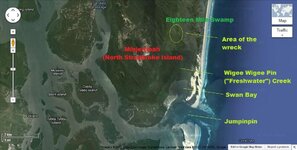
Aboriginal Elders had told people they had taken there that the wreck was just "an old cattle barge". Because it was just what was left of the flat middle section of the ship? A mere "cattle barge" that had been fastened with high quality copper bolts? Some say the wreck they have seen is too short for it to have been a larger ship. There are two areas of wreckage. Is it only one section of a wreck broken up by the tsunami?
Please do not attempt to enter the swamp without first asking for permission from the Elders:
https://www.facebook.com QuandamookaYoolooburrabeeAboriginalCorporation Permission would also need to be gained from National Parks and Wildlife Services, because it's in a National Park.There is some danger involved, poisonous snakes for which the swamp is the ideal habitat. It would be well advised to take an experienced guide on any expedition there. Without exact GPS coordinates from that scan of the swamp however, it will be almost impossible to find the wreck. Before you ask, sorry, I have seen the scan of the swamp showing the area with metal in it but don't own the image so I'm afraid I can't post it here (note: I now know that the so-called scan is nothing but a fake. I should also mention that there is most likely nothing of the gold at the wreck site, because the mutineers, going by latest evidence, had removed it before setting fire to the ship. Can't say any more about this however).
Some sources: 1) The Argus (Melbourne) Sat 22 Feb 1936, Page 8; 2) Australian Town and Country Journal, Sat 21 December 1872 Page 8
Information re Matthew Heeb's finds: Various articles by historian Isobel Hannah in the Brisbane Courier in 1921, Various articles re the "Extraordinary Tidal Disturbances" of 1868 and 1877, Thomas Welsby's Collected Works, My own photos of the bell.
If you do manage to gain access and find something, the Stradbroke Island Historical Museum would love to hear from you. Above all, this thread is dedicated to Fraser Brown, accused of being a thief just because he found something on the wreck in the swamp. If it can finally be proven that this wreck is indeed what is left of the Madagascar, this one is for Fraser!
Attachments
Last edited:


